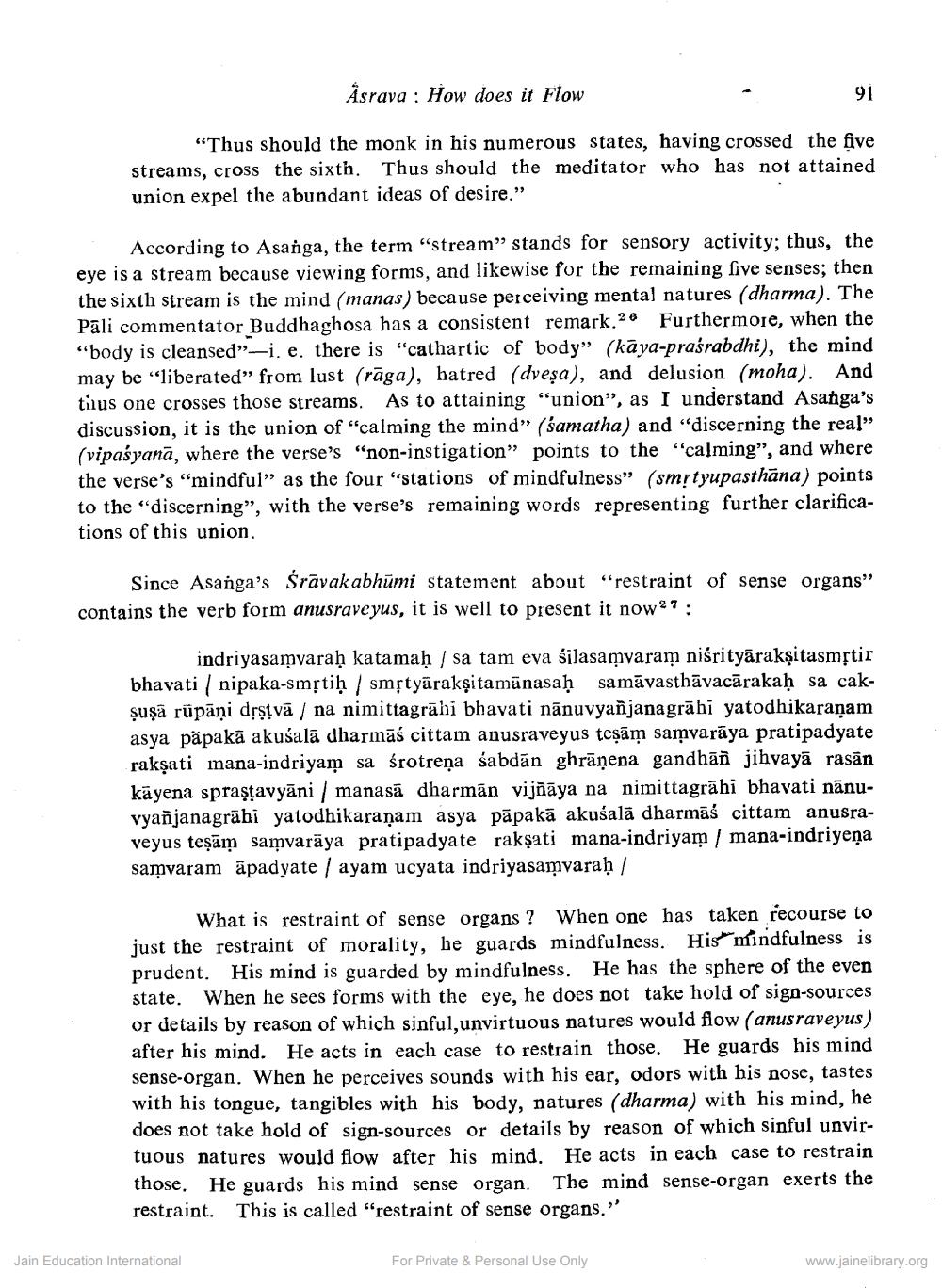Book Title: Asarva how does it flow Author(s): Alex Wayman Publisher: Z_Aspect_of_Jainology_Part_3_Pundit_Dalsukh_Malvaniya_012017.pdf View full book textPage 4
________________ Åsrava : How does it Flow "Thus should the monk in his numerous states, having crossed the five streams, cross the sixth. Thus should the meditator who has not attained union expel the abundant ideas of desire." According to Asanga, the term "stream” stands for sensory activity; thus, the eye is a stream because viewing forms, and likewise for the remaining five senses; then the sixth stream is the mind (manas) because perceiving mental natures (dharma). The Pāli commentator Buddhaghosa has a consistent remark.26 Furthermore, when the “body is cleansed”--i. e. there is "cathartic of body" (kāya-praśrabdhi), the mind may be “liberated” from lust (rāga), hatred (dveșa), and delusion (moha). And tilus one crosses those streams. As to attaining "union”, as I understand Asanga's discussion, it is the union of "calming the mind” (samatha) and "discerning the real” (vipaśyanā, where the verse's "non-instigation" points to the "calming”, and where the verse's "mindful” as the four "stations of mindfulness” (smrtyupasthāna) points to the “discerning”, with the verse's remaining words representing further clarifications of this union. Since Asanga's Srāvakabhūmi statement about “restraint of sense organs” contains the verb form anusraveyus, it is well to present it now27: indriyasamvaraḥ katamaḥ / sa tam eva silasamvaram nisrityārakṣitasmộtir bhavati nipaka-smstiḥ / smstyārakṣitamānasaḥ samāvasthāvacārakaḥ sa cakşuşā rūpāņi drstva / na nimittagrāhi bhayati nānuvyañjanagrāhi yatodhikaraṇam asya päpakā akušalā dharmāś cittam anusraveyus teşām samvarāya pratipadyate rakṣati mana-indriyam sa śrotreņa sabdan ghrānena gandhān jihyaya rasan kāyena spraştavyāni / manasă dharmán vijñāya na nimittagrāhi bhavati nānuvyañjanagrābi yatodhikaraṇam asya pāpakā akusalā dharmāś cittam anusraveyus teşām samvarāya pratipadyate rakṣati mana-indriyam / mana-indriyeņa samvaram āpadyate / ayam ucyata indriyasamvaraḥ / What is restraint of sense organs? When one has taken recourse to just the restraint of morality, be guards mindfulness. His mindfulness is prudent. His mind is guarded by mindfulness. He has the sphere of the even state. When he sees forms with the eye, he does not take hold of sign-sources or details by reason of which sinful,unvirtuous natures would flow (anusraveyus) after his mind. He acts in each case to restrain those. He guards his mind sense-organ. When he perceives sounds with his ear, odors with his nose, tastes with his tongue, tangibles with his body, natures (dharma) with his mind, he does not take hold of sign-sources or details by reason of which sinful unvirtuous natures would flow after his mind. He acts in each case to restrain those. He guards his mind sense organ. The mind sense-organ exerts the restraint. This is called "restraint of sense organs." Jain Education International For Private & Personal Use Only www.jainelibrary.orgPage Navigation
1 2 3 4 5 6 7 8
